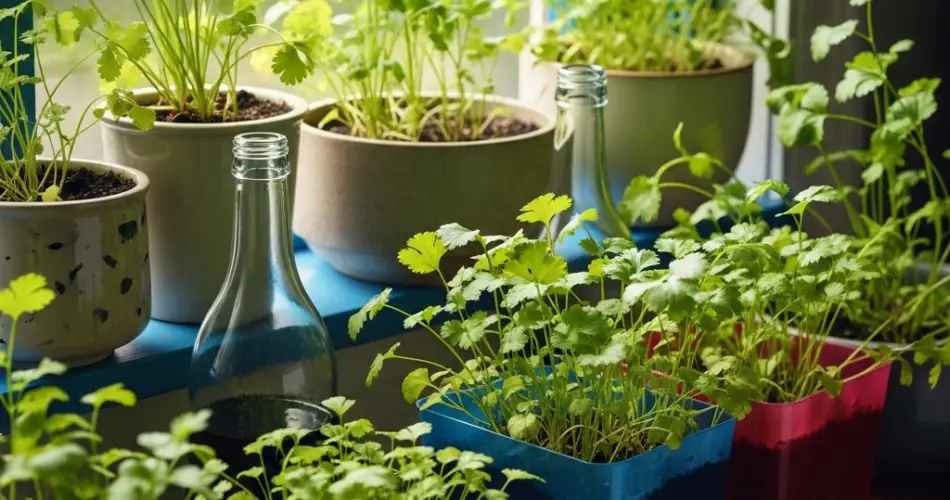Cilantro, also known as coriander, is a fast-growing herb with a zesty, citrus-like flavor that enhances countless recipes. Whether used fresh in salsa, sprinkled over soups, or added to curries, cilantro is a kitchen essential for home cooks. One of the easiest and most convenient ways to keep this flavorful herb within reach is to grow it right on your windowsill.
Container gardening makes it possible to enjoy fresh cilantro even if you don’t have an outdoor garden. With the right setup, you can successfully grow cilantro indoors year-round, harvesting fresh leaves whenever your cooking calls for them.
Why Grow Cilantro Indoors in Containers?
Cilantro thrives in cool temperatures and consistent light—conditions that can be easily controlled indoors. Growing cilantro on your windowsill offers several benefits:
-
Easy access for daily cooking
-
Controlled environment to prevent premature flowering (bolting)
-
No weeding or pests from the outdoors
-
Perfect for small-space gardening like apartments or urban homes
-
Year-round harvest, even in winter
With just a container, seeds, and sunlight, you can cultivate a steady supply of flavorful cilantro indoors.
Best Containers for Indoor Cilantro
Cilantro develops a long taproot, so choosing the right container is important.
Container features:
-
Depth: At least 8 inches to allow the root to grow deeply
-
Width: A 10–12 inch wide pot supports multiple plants or successive sowings
-
Material: Plastic, ceramic, or terracotta pots all work well indoors
-
Drainage holes: Essential to prevent water from pooling and causing root rot
Place a saucer underneath to catch excess water without damaging your windowsill.
Choosing the Right Soil
Cilantro prefers loose, well-draining, nutrient-rich soil. For indoor growing, a quality potting mix designed for herbs or vegetables is ideal.
You can also mix:
-
2 parts potting soil
-
1 part compost
-
1 part perlite or coarse sand for improved drainage
Avoid using garden soil indoors, as it may contain pests or compact too easily.
Planting Cilantro Seeds
Cilantro grows best when directly sown from seed, as it doesn’t transplant well. Here’s how to get started:
-
Fill the container with prepared soil, leaving an inch at the top.
-
Sprinkle seeds evenly, about ½ inch apart across the surface.
-
Cover lightly with ¼ inch of soil and water gently.
-
Place the pot on a bright windowsill with at least 4–6 hours of sunlight daily.
Germination takes about 7–10 days. Once seedlings reach 2 inches tall, thin them to about 2–3 inches apart, leaving the strongest ones to grow.
Light and Temperature Requirements
Cilantro thrives in cool, bright environments. The best indoor location is a south- or east-facing windowsill where the plant can get morning and midday sun.
Ideal conditions:
-
4–6 hours of direct sunlight daily
-
Temperatures between 60°F and 75°F (15°C to 24°C)
-
Good airflow to reduce humidity buildup
If your windowsill gets limited light, consider using a grow light to supplement. Position it about 6 inches above the plant and run it for 10–12 hours daily.
Watering and Feeding Cilantro Indoors
Indoor cilantro requires consistent but not excessive moisture. Let the top inch of soil dry out slightly between waterings.
Tips for watering:
-
Water gently at the base to avoid disturbing roots
-
Use room-temperature water
-
Never let the container sit in standing water
Feed cilantro every 3–4 weeks using a diluted liquid fertilizer or compost tea. Over-fertilizing can lead to tall, spindly plants with weaker flavor.
Harvesting for Maximum Yield
Once your cilantro is about 6 inches tall, you can start harvesting. Regular cutting promotes fresh growth and delays flowering.
Harvesting tips:
-
Snip outer leaves first, about 1–2 inches above the soil
-
Avoid cutting the central growth stem early on
-
Never remove more than one-third of the plant at once
-
Pinch off flower stalks as they appear to keep leaves tender and flavorful
Frequent harvesting helps keep the plant in its leafy stage longer before it bolts and goes to seed.
Succession Planting for Ongoing Harvests
Because cilantro matures quickly and tends to bolt, stagger your plantings every 2–3 weeks for a continuous indoor supply.
You can:
-
Use a long container to sow one section at a time
-
Plant new seeds in a second pot as the first begins to age
-
Save coriander seeds from older plants for replanting
This ensures a fresh crop is always coming in as the previous one finishes.
Common Indoor Growing Problems
-
Leggy growth: Usually due to low light—move to a sunnier window or add a grow light.
-
Bolting: Triggered by high temperatures or dry soil—keep the plant cool and well-watered.
-
Yellowing leaves: May indicate overwatering or poor drainage—check the soil and reduce frequency.
-
Pests: Rare indoors, but aphids or spider mites can appear—spray with neem oil if needed.
Conclusion
Growing cilantro on your windowsill in containers is a simple and satisfying way to enjoy this fresh, zesty herb year-round. With a deep pot, good soil, bright light, and a little attention, you can cultivate healthy cilantro plants that reward you with delicious leaves for months. Whether you’re making guacamole, pho, or a garden salad, there’s nothing better than reaching over to snip a few sprigs of homegrown cilantro right from your window.



